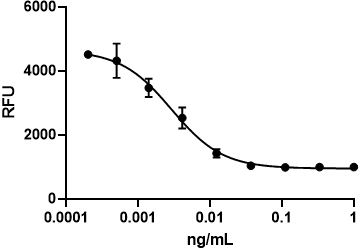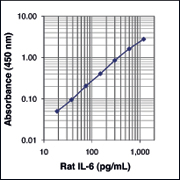- Regulatory Status
- RUO
- Other Names
- Catabolin, interleukin-1 beta, preinterleukin 1 beta, pro-interleukin-1-beta, IL-1b
- Ave. Rating
- Submit a Review
- Product Citations
- publications

-

Recombinant Rat IL-1β induces the proliferation of mouse D10.G4.1 cell line in a dose dependent manner. BioLegend’s protein was compared side-by-side to a competitor’s equivalent product.
IL-1β does not encode a typical signal peptide. As a result, newly synthesized pro-IL-1β accumulates within the cytoplasm of activated monocytes and macrophages. The conversion of the inactive pro-IL-1β to its mature form requires the proteolytic action from the IL-1β-converting enzyme (ICE), which is also termed as caspase-1. Secretion of mature IL-1β from LPS-activated monocytes/macrophages is not a constitutive process. These cells must encounter a secondary stimulus that specifically activates the post-translational processing events. Moreover, owing to its pro-inflammatory nature, IL-1β is considered a tumor-promoting cytokine. In fact, enhanced tumor metastasis and angiogenesis have been observed under the influence of IL-1β. IL-1β is able to facilitate tumor progression in murine models of lung cancer. Additionally, the promotion of metastasis and tumor angiogenesis by IL-1β have been associated with increased activity of matrix metalloproteinases and expression of the pro-angiogenic molecule hepatocyte growth factor. IL-1β plays a pathogenic role in Type 1 and Type 2 diabetes, rheumatoid arthritis, and osteoarthritis among other diseases.
Product DetailsProduct Details
- Source
- Rat IL-1β, amino acids Met-(Val 117-Ser268) (Accession# NM_031512), was expressed in E. coli.
- Molecular Mass
- The 153 amino acid recombinant protein has a predicted molecular mass of approximately 17.4 kD. The DTT-reduced and non-reduced protein migrates at approximately 18 kD by SDS-PAGE. The predicted N-terminal amino acid is Met.
- Purity
- >95%, as determined by Coomassie stained SDS-PAGE.
- Formulation
- 0.22 µm filtered protein solution is in PBS, pH 7.2.
- Endotoxin Level
- Less than 0.01 ng per µg cytokine as determined by the LAL method.
- Concentration
- 10 and 25 µg sizes are bottled at 200 µg/mL. 100 µg size and larger sizes are lot-specific and bottled at the concentration indicated on the vial. To obtain lot-specific concentration and expiration, please enter the lot number in our Certificate of Analysis online tool.
- Storage & Handling
- Unopened vial can be stored between 2°C and 8°C for up to 2 weeks, at -20°C for up to six months, or at -70°C or colder until the expiration date. For maximum results, quick spin vial prior to opening. The protein can be aliquoted and stored at -20°C or colder. Stock solutions can also be prepared at 50 - 100 µg/mL in appropriate sterile buffer, carrier protein such as 0.2 - 1% BSA or HSA can be added when preparing the stock solution. Aliquots can be stored between 2°C and 8°C for up to one week and stored at -20°C or colder for up to 3 months. Avoid repeated freeze/thaw cycles.
- Activity
- Rat IL-1β induces the proliferation of D10.G4.1 mouse helper lymphocytes in a dose-dependent manner. The ED50 = 0.05 - 0.25 ng/mL.
- Application
-
Bioassay
- Application Notes
-
BioLegend carrier-free recombinant proteins provided in liquid format are shipped on blue-ice. Our comparison testing data indicates that when handled and stored as recommended, the liquid format has equal or better stability and shelf-life compared to commercially available lyophilized proteins after reconstitution. Our liquid proteins are verified in-house to maintain activity after shipping on blue ice and are backed by our 100% satisfaction guarantee. If you have any concerns, contact us at tech@biolegend.com.
Antigen Details
- Structure
- Cytokine.
- Distribution
-
IL-1β is produced by monocytes, macrophages, microglia, keratinocytes, stimulated B lymphocytes, fibroblasts, endothelial cells, and epithelial cells. Mononuclear cells secrete the highest levels of IL-1β.
- Function
- IL-1β is a cytokine with a key role in the pathophysiology of local and systemic inflammation. IL-1β induces cytokine, chemokine, proinflammatory molecule secretion, and adhesion molecule expression in diverse cells. IL-1β is induced by high concentrations of glucose, free fatty acids, and leptin in pancreatic beta cells. IL-1R antagonist binds to IL-1R type I without inducing a response, which blocks the binding of IL-1β to the receptor.
- Interaction
- Multiple cells.
- Ligand/Receptor
- Type I and II IL-1 receptors (IL-1RI and IL-RIII).
- Cell Type
- Hematopoietic stem and progenitors
- Biology Area
- Cell Biology, Immunology, Innate Immunity, Neuroinflammation, Neuroscience, Stem Cells
- Molecular Family
- Cytokines/Chemokines
- Antigen References
-
1. Stevenson FT, et al. 1992. J. Cell Physiol. 152:223.
2. Shi J, et al. 2007. J. Immunol. 179:1245.
3. Dinarello CA. 2006. Cancer Metastasis Rev. 25:307.
4. Boost KM, et al. 2008. BMC Cancer 8:265.
5. Dinarello CA. 2011. J. Internal Med. 269:16. - Gene ID
- 24494 View all products for this Gene ID
- UniProt
- View information about IL-1beta on UniProt.org
Related FAQs
- Why choose BioLegend recombinant proteins?
-
• Each lot of product is quality-tested for bioactivity as indicated on the data sheet.
• Greater than 95% Purity or higher, tested on every lot of product.
• 100% Satisfaction Guarantee for quality performance, stability, and consistency.
• Ready-to-use liquid format saves time and reduces challenges associated with reconstitution.
• Bulk and customization available. Contact us.
• Learn more about our Recombinant Proteins. - How does the activity of your recombinant proteins compare to competitors?
-
We quality control each and every lot of recombinant protein. Not only do we check its bioactivity, but we also compare it against other commercially available recombinant proteins. We make sure each recombinant protein’s activity is at least as good as or better than the competition’s. In order to provide you with the best possible product, we ensure that our testing process is rigorous and thorough. If you’re curious and eager to make the switch to BioLegend recombinants, contact your sales representative today!
- What is the specific activity or ED50 of my recombinant protein?
-
The specific activity range of the protein is indicated on the product datasheets. Because the exact activity values on a per unit basis can largely fluctuate depending on a number of factors, including the nature of the assay, cell density, age of cells/passage number, culture media used, and end user technique, the specific activity is best defined as a range and we guarantee the specific activity of all our lots will be within the range indicated on the datasheet. Please note this only applies to recombinants labeled for use in bioassays. ELISA standard recombinant proteins are not recommended for bioassay usage as they are not tested for these applications.
- Have your recombinants been tested for stability?
-
Our testing shows that the recombinant proteins are able to withstand room temperature for a week without losing activity. In addition the recombinant proteins were also found to withstand four cycles of freeze and thaw without losing activity.
- Does specific activity of a recombinant protein vary between lots?
-
Specific activity will vary for each lot and for the type of experiment that is done to validate it, but all passed lots will have activity within the established ED50 range for the product and we guarantee that our products will have lot-to-lot consistency. Please conduct an experiment-specific validation to find the optimal ED50 for your system.
- How do you convert activity as an ED50 in ng/ml to a specific activity in Units/mg?
-
Use formula Specific activity (Units/mg) = 10^6/ ED50 (ng/mL)
 Login / Register
Login / Register 











Follow Us